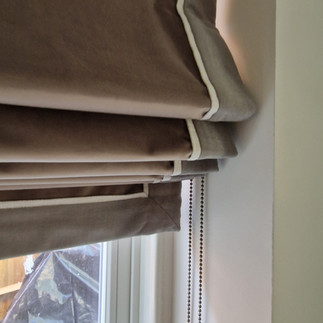Curtains are more than just window dressings; they play a crucial role in the overall aesthetic and functionality of a room. One of the key components that can significantly impact your curtains’ performance is the lining. But with various types of curtain linings available, how do you know which one is right for you? Let’s explore the different types of curtain linings and their benefits.
1. Standard Lining
Description: Standard curtain linings are typically made from polyester or a cotton blend. They are the most common type of lining and come in a variety of weights and finishes.
Benefits:
Light Control: Standard linings help to diffuse natural light, providing a softer glow in the room.
Privacy: They offer a moderate level of privacy, ideal for living rooms and dining areas.
Durability: These linings are durable and easy to maintain, making them suitable for everyday use. When used as loose linings they are often washable.
2. Blackout Lining
Description: Blackout linings are made from a tightly woven fabric, often with an additional layer of foam or plastic to completely block out light.
Benefits:
Light Control: Perfect for bedrooms or media rooms, blackout linings help prevent light from entering the room, ensuring a good level of darkness.
Energy Efficiency: They help to insulate your windows, keeping your home warmer in winter and cooler in summer, thus saving on energy bills.
Noise Reduction: Blackout linings can also help to reduce outside noise, creating a quieter environment.
When using blackout linings, there needs to be some understanding that different styles of window treatment will also contribute to the level of blackout achieved. For instance, a roman blind fitted in the recess of a window will have light seepage around the edges, where there are small gaps for the blind to operate. Full ceiling to floor curtains will give a better level of coverage. Total blackout can only really be achieved when all gaps are filled using something like a framed blind or lots of layers of blinds, curtains and pelmets.

3. Thermal Lining
Description: Thermal linings are designed to provide extra insulation. They are usually made from thick, heavy fabrics with insulating properties.
Benefits:
Energy Efficiency: Similar to blackout linings, thermal linings help to regulate the temperature in your home by keeping the heat in during winter and blocking out the heat in summer.
Comfort: They create a more comfortable living environment by maintaining a consistent temperature.
Eco-Friendly: By reducing the need for heating and cooling, thermal linings are an environmentally friendly option.
4. Interlining
Description: Interlining is an additional layer of fabric placed between the main curtain fabric and the lining. It is usually made from a soft, fluffy material like cotton or flannel.
Benefits:
Luxury: Interlining gives curtains a fuller, more luxurious appearance, enhancing the overall look and feel of the room.
Insulation: It provides extra insulation, helping to keep your home warm and reducing energy consumption.
Soundproofing: Interlined curtains offer better soundproofing, making them ideal for rooms that need to be kept quiet.

Conclusion
Choosing the right curtain lining depends on your specific needs and the room where the curtains will be used. Whether you prioritize light control, insulation, noise reduction, or energy saving, there’s a curtain lining that can meet your requirements. By understanding the different types of linings and their benefits, you can make an informed decision and enhance the comfort and style of your home.







Comments